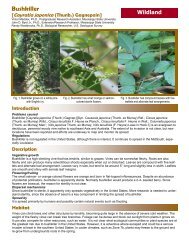RATopic1_95 - Geosystems Research Institute - Mississippi State ...
RATopic1_95 - Geosystems Research Institute - Mississippi State ...
RATopic1_95 - Geosystems Research Institute - Mississippi State ...
You also want an ePaper? Increase the reach of your titles
YUMPU automatically turns print PDFs into web optimized ePapers that Google loves.
Task 1.1. Growth of Common Salvinia (Salvinia minima) and Waterhyacinth<br />
(Eichhornia crassipes) as Regulated by Loading Rates of Water Column Nitrogen<br />
and Phosphorus<br />
PI: John Madsen<br />
Collaborators: Randy Westbrooks, USGS<br />
Common reed (Phragmites<br />
australis) is a non-native<br />
invasive perennial grass<br />
that creates a nuisance in<br />
aquatic and riparian environments<br />
across the United<br />
<strong>State</strong>s. The ability of common<br />
reed to reproduce<br />
quickly combined with its<br />
ability to cycle nutrients has<br />
made it an aggressive invader<br />
of riparian and wetland<br />
ecosystems. Phragmites<br />
often forms monotypic<br />
stands that displace<br />
native vegetation more desirable<br />
as wildlife food and<br />
cover than Phragmites.<br />
Phragmites has been differentiated<br />
into 29 haplotypes,<br />
13 haplotypes being native<br />
to North America, and 16<br />
non-native haplotypes. The<br />
European haplotype M and<br />
South American/Asian haplotype<br />
I are of concern due<br />
to their ability to out compete<br />
native vegetation, alter<br />
hydrology, and change<br />
community structure of<br />
aquatic and riparian habitats.<br />
An understanding of<br />
Life History and Starch Allocation of Common Reed (Phragmites australis)<br />
Joshua C. Cheshier and John D. Madsen<br />
common reed life history and starch allocation can be used as a predictive tool in management regimes and wetland planning<br />
and restoration. Our objectives were to measure the biomass and starch allocation of common reed over a two year<br />
period to get identify trends in the growth of common reed.<br />
Life History<br />
Figure 1. Average biomass allocation of above and below ground tissues of common reed<br />
in the Mobile River Delta.<br />
Common reed was sampled every month for two years beginning in January 2006 and ending in December 2007. 48, 1<br />
m 2 samples were taken from the Mobile River Delta in southern Alabama each month and separated to above and below<br />
ground tissues, then dried at 70ºC for 72 hrs to obtain a constant weight. Biomass were analyzed using a mixed model<br />
procedure in SAS and differences were assessed at P




